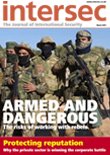Chemistry lesson
Professor Lijun Shang explains the importance of rethinking biological security education to strengthen the Biological and Toxin Weapons Convention
At the turn of the century more than 20 years ago Matthew Meselson, Professor of Molecular Biology at Harvard University, suggested that, as all previous scientific and technological revolutions had been applied in major ways to hostile purposes, it is probable that the same could happen to the revolution in civil biotechnology unless we find ways to prevent that happening. He also thought that this would be a long-term struggle, and noted that dangerous capabilities could be available to a much wider range of actors than are available in relation to nuclear weapons stating that: “Unlike the technologies of conventional or even nuclear weapons, biotechnology has the potential to place mass destructive capabilities in a multitude of hands… in coming decades… it should be evident that any intensive exploitation of biotechnology for hostile purposes could take humanity down a particularly undesirable path.”
The COVID-19 pandemic has demonstrated just how dangerous the misuse of the modern life science could be. Indeed, as one former US Assistant Secretary of Defense pointed out in 2021: “As bad as this pandemic is, imagine if instead it were caused by the deliberate release of a sophisticated biological weapon. About 2 percent of those infected have died of COVID-19, while a disease such as smallpox kills at a 30 percent rate. A bioengineered pathogen could be even more lethal. “
Preventing humanity going down this undesirable pathway will require efforts across many fields of activity, but one absolutely critical task is to engage the life science community effectively in protecting its benignly intended research from potential misuse.
This in part requires the implementation of codes of conduct that include dealing with the problem of dual use – the fact that the results of benignly-intended work could be used by others for malign purposes. The Tianjin Biosecurity Guidelines proposed by China and Pakistan in the Intersessional meetings leading up to the 9th BWC Review Conference in 2023 are intended to do just that; but they will not be operationalised without a vast effort to improve the biosecurity education of life and associated scientists.
Without such education, how can scientists be expected to see the need for a biosecurity code? It is a particularly challenging task to investigate, design and initiate the most effective means of filling this critical educational gap specifically identified by the World Health Organisation in its 2022 Global Framework for the Responsible Use of the Life Sciences. As the WHO noted: “A chronic and fundamental challenge is a widespread lack of awareness that work in this area – which is predominantly undertaken to advance knowledge and tools to improve health, economies and societies – could be conducted or misused in ways that result in health and security risks to the public.”
The problem of governing dual-use research has been of increasing concern to States Parties of the Biological and Toxin Weapons Convention (BTWC) as the revolution in the life and associated sciences has accelerated. Strengthening the BTWC has been difficult to achieve during the last two decades following the failure to agree a verification protocol in 2001, but there may be the opportunity to achieve progress after the COVID-19 pandemic, because there is bound to be a reassessment of the dangers of natural, accidental and deliberate diseases, and this must include finding ways to minimise the possibility that the beneficial advances being made in the life sciences are not misused for hostile purposes by States, sub-State groups or even individuals.
Clearly, a major problem in strengthening the BTWC is that very few life scientists are even aware of the Convention or that their work has been misused in the past and could be misused again in the future over the last two decades.
States Parties have expended considerable efforts at meetings in 2005, 2008 and particularly since 2015 in investigating and discussing what might be done to close this gap in the overall web of preventive policies. That is why in recent years some State Parties have developed – and many others have supported – the Tianjin Biosecurity Guidelines for Codes of Conduct under the BTWC for life scientists. It is also why a key element in these guidelines is the requirement for biosecurity education. Reason being, scientists are unlikely to engage with the guidelines and related codes if they do not understand the dangers that the guidelines and codes address.
Similar issues have arisen and been confronted by States Parties dealing with Nuclear and Chemical Weapons of Mass Destruction. The International Atomic Energy Agency has organised and funded an International Nuclear Security Education Network that has, for several decades, developed and implemented nuclear security education around the world, and since 2015, when the States Parties to the Chemical Weapons Convention (CWC) endorsed the Hague Ethical Guidelines for Chemists under the CWC, its Advisory Board on Education and Outreach (ABEO) has initiated similar work for chemists. However, as the WHO’s report made clear, there has been no such international organisation and effort to deal with the problem of dual use in the life sciences – where the dangers may well be greater due to the growing ease with which advances in the life sciences could be misused.
Drawing on the innovative security education work in the nuclear and chemical communities, and biosecurity education projects carried out in recent years, we now have the means to radically improve biosecurity education for life and associated scientists – and therefore greatly diminish the threat of the dual use of the life sciences. That is, if we design an implementation strategy for an International Biological Security Education Network, which could be put into place within a few years.
The work done in the past 20 years globally demonstrates that there is widespread agreement on the benefits of inputs from the civil society to the policy making, in order to promote the strengthening of the BTWC over the next 5-10 years. Despite the difficult international security situation and the hostile nature of the international environment, State Parties to the Biological and Toxin Weapons Convention reached a consensus agreement to initiate a renewed effort to strengthen the Convention at the 9th Five-Year Review Conference in Geneva in December 2022. The key element of this new initiative was the establishment of the working group to: “strengthen and institutionalise the Convention in all its aspects”. The objective is to produce institutional mechanisms that will allow for verification and compliance within BTWC member States.
The working group has already successfully concluded two sessions of meetings in March and August 2023 and will continue meetings in December 2023 and during 2024. The working group also agreed their objectives and timetable for meetings to achieve their objectives over the next two to three years. The agreed agenda and timetable include a focus on verification processes and a repeated focus on scientific and technological developments relevant to the Convention and the setting up of a science and technology review mechanism for the Convention.
Civil Society and the scientific community in particular have played a role in helping facilitate the negotiation and development of the BTWC and the CWC for many years. Numerous efforts have been made over the last two decades to develop effective methods of teaching life scientists about the general problem of biosecurity and particularly about the specific problem of dual-use, for example by the use of cartoons developed as part of a Biological and Chemical Security Project implemented by London Metropolitan University, UK. The cartoon series is open source and available in all six official UN languages.
Recently, London Met was awarded a new grant by Joseph Rowntree Charitable Trust to address the urgent need for improvement in biosecurity education for life and associated scientists and technologists. In this new project, we will investigate the lessons that can be drawn from the work of the INSEN and ABEO and the work within the life sciences on implementation of the Tianjin Guidelines and biosecurity education in order to propose a framework and implementation strategy for an International Biological Security Education Networks. Specific objects are: to provide a systematic review and comparison report on awareness raising and education from INSEN and ABEO; provide a summary of education on biological security globally in the past 20 years; and initiate an outline framework of proposed IBSEN combing with good practice summary and future recommendations. This will then provide the basis for the further development of this worldwide network in the later stages of the project to engage life scientists and educators in developing courses at BSc, MSc, PhD and continuing education levels.
The eventual target audience of this network is the international life and associated science community with the ethical, legal and social objective of adding considerations of biosecurity and dual use to their concept of the responsible conduct of science.
The outcome could be useful to all stakeholders, including BTWC and WHO, as it will help to produce a roadmap to improve the biosecurity education globally. The aim is not only to design specific courses for biosecurity specialists, but to produce something that can be widely used to engage life and associated scientists at different stages of their careers. This goes further than creating awareness-raising products – rather, courses that are carefully evaluated in order to ensure a more systematic understanding of the problem of dual use and what might be done to improve governance of life science research.
Beyond the design of core courses, we think it is necessary to investigate how biosecurity education can be implemented and shared across the world in the many different countries in a sustainable manner and in the many different fields of research, within the life sciences and in associated areas including information technology and artificial intelligence. In this way, we hope to greatly help in strengthening BTWC and its science and technology review mechanism.
Professor Lijun Shang is Director of London Metropolitan University’s Biological Security Research Centre (BSRC). The work from the London Metropolitan University Biological Security Research Centre is supported by grants from the Joseph Rowntree Charitable Trust, the Transformation grant and the Rescaling grant from London Metropolitan University.







